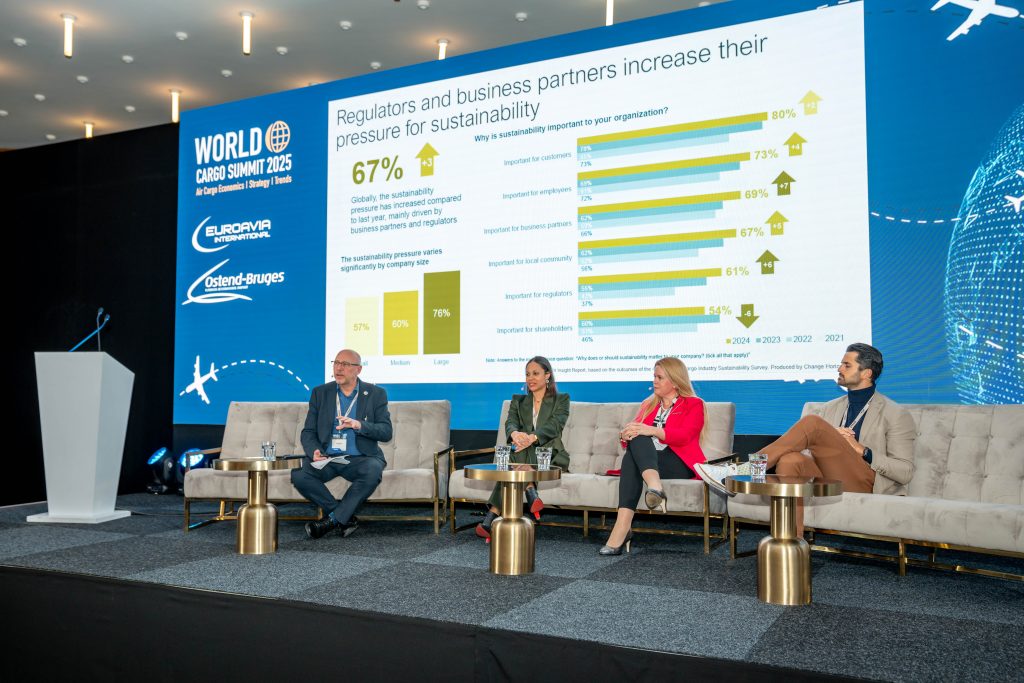The air cargo industry is at a crossroads regarding sustainability. While airlines and logistics companies are committed to reducing their carbon footprint, one of the biggest roadblocks remains the availability and scalability of Sustainable Aviation Fuel (SAF).
This issue took centre stage during a panel discussion at the World Cargo Summit (WCS) in Ostend, where industry leaders addressed the challenges of SAF adoption and what needs to happen to make it a viable solution for the future.
The gap between SAF ambitions and reality
SAF has been widely promoted as the key to decarbonising aviation, offering up to 80 percent lower carbon emissions compared to conventional jet fuel. However, the reality is stark—current production levels are nowhere near what’s needed to meet global demand. With the European Union mandating a 2 percent SAF blend by 2025 and aiming for 65 percent by 2050, the industry is facing a supply crisis.
Anna-Maria Kirchner, Head of Global Sales, Finnair Cargo, highlighted that while there is sufficient SAF to meet today’s requirements, scaling up to meet future mandates will be extremely difficult without significant investments. “We need more refineries, more technological advancements, and a broader mix of feedstocks to produce SAF efficiently,” she noted.
One of the main barriers to SAF adoption is its high cost. Currently, SAF is two to five times more expensive than traditional jet fuel, making it financially unfeasible for many airlines and freight operators. Dr. Fabiano Piccinno, Air Logistics Global Head of Sustainability, Kuehne + Nagel, emphasised that while airlines are willing to invest, they cannot shoulder the financial burden alone. “Governments need to provide incentives, subsidies, and policy frameworks that make SAF a cost-competitive alternative,” he explained. Drs. Francine Carron, Founder, ESG-Consultance N.V, pointed out that while corporate customers are demanding greener solutions, they are not always willing to pay the premium for SAF-driven transport.
“Commitments are strong in principle, but the industry needs mechanisms that make green choices economically viable,” she said. Another major challenge is the lack of SAF production facilities. Currently, the majority of SAF is produced using waste cooking oils and animal fats, but this feedstock supply is limited.
The panellists agreed that to truly scale SAF, the industry must explore alternative sources, such as: Power-to-liquid (PtL) technologies – Creating synthetic SAF using captured carbon and renewable energy. Algae-based fuels – A promising long-term solution with high energy density and sustainability potential. Biomass-to-liquid (BtL) processes – Converting forestry and agricultural waste into sustainable fuel. However, building and certifying these new production methods will take years, if not decades.
The panel stressed the urgent need for investment in R&D to accelerate SAF development. SAF adoption is also being hindered by inconsistent global regulations. While Europe has taken a leading role in enforcing SAF mandates, other regions lack clear policies. This disparity creates uncertainty for airlines and logistics providers that operate across international markets. “We need global alignment on SAF incentives and regulations,” Kirchner urged.
“A fragmented approach will slow progress and increase costs”…
Imagen: World Cargo Summit



